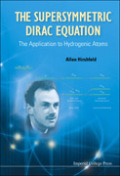
The supersymmetric Dirac equation: the application to hydrogenic atoms
Hirshfeld, Allen
The solution of the Dirac equation for an electron in a Coulomb field is systematically treated here by utilizing new insights provided by supersymmetry. It is shown that each of the concepts has its analogue in the non-relativistic case. Indeed, the non-relativistic case is developed first, in order to introduce the new concepts in a familiar context. The symmetry of the non-relativistic model is already present in the classical limit, so the classical Kepler problem is first discussed in order to bring out the role played by the Laplace vector, one of the central concepts of the whole book. Analysis of the conceptof eccentricity of the orbits turns out to be essential to understanding the relation of the classical and quantum mechanical models. The opportunity is taken to relive the great moments of physics: From Kepler's discovery of the laws of motion of the planets, the development is traced through the Dirac equation up to modern advances, which bring the concepts of supersymmetry to bear onthe derivation of the solutions. INDICE: The Classical Kepler Problem; Symmetry of the Classical Problem; From Solar Systems to Atoms; The Bohr Model; Interpretation of the Quantum Rules; Sommerfeld's Model for Non-Relativistic Electrons; Quantum Mechanics of Hydrogenic Atoms; The Schrödinger Equation and the Confluent Hypergeometric Functions; Non-Relativistic Hydrogenic Atoms with Spin; Elements of Supersymmetric Quantum Mechanics; Sommerfeld's Derivation of the Relativistic Energy Level Formula; The Dirac Equation; The Primary Supersymmetry of the Dirac Equation; Extending the Solution Space; A Different Extension of the Solution Space; The Relation of the Solutions to Kramer's Equation; Non-Relativistic Approximation.
- ISBN: 978-1-84816-797-1
- Editorial: Imperial College
- Encuadernacion: Cartoné
- Páginas: 216
- Fecha Publicación: 01/12/2011
- Nº Volúmenes: 1
- Idioma: Inglés
